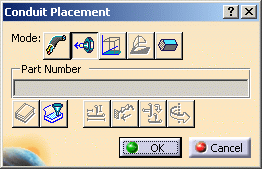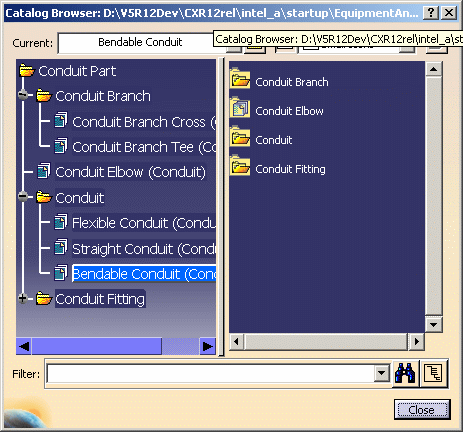This type of parts placement is known as "functionless" parts placement. It is used in Raceway & Conduit Design, and also in Equipment Arrangement. These parts do not have a function as defined in the feature dictionary. Instead of opening a class browser, you open the catalog browser.
See also Detecting Clash in Parts Placement and Placing Parts Using a Schematic.
Note that this application incorporates intelligent design functions. This means that during the design process the application ensures your design meets certain criteria. These criteria are established by design rules. For example in Piping, the design rules will match the threaded end of a pipe to the threaded end of a mating part. (You can override the rules if you want.) There are certain general design rules that apply to all parts you place. Other rules apply to parts you place from a specifications catalog or a standard. Theoretically you can create a new standard and not incorporate any design rules. However, your parts will not place correctly if you do so.
The standard and specifications catalog that you use for parts placement has to be defined in the setup data. See Understanding Project Resource Management.
It is recommended that you place a datum point on each part connector to which a flexible may be routed. This is needed to allow a flexible to update when you move a part in a design.
When you place an object using this command, a unique reference will be created and placed in the CATTemp directory. The instance will not point to the catalog. If you want the instance to point to the catalog reference then you need to add a keyword to the family to which the part belongs. Add the following to the family, using the Catalog Editor:
- Name - LoadType;
- Type - String;
- Default Value - SameReference.
To learn how to add a keyword see Creating a Catalog in the Component Catalog Editor user guide.
Parts that are placed in free space inherit some property values from the Line ID menubar. See Using the Line ID Menubar.
1.

Select the mode by clicking one of the buttons.
![]() Place on Object to
place a part on a run.
Place on Object to
place a part on a run.
![]() Place on
Connector to place a part on a connector.
Place on
Connector to place a part on a connector.
![]() Place on
Active Axis Plane. This will place the part on the same plane as the axis
that is active. You could use this with a local axis, for instance.
Place on
Active Axis Plane. This will place the part on the same plane as the axis
that is active. You could use this with a local axis, for instance.
![]() Place on
Compass Plane. This mode allows you to place a part on the compass plane.
It becomes active when you move the compass and place it on a surface.
Place on
Compass Plane. This mode allows you to place a part on the compass plane.
It becomes active when you move the compass and place it on a surface.
![]() Place on Surface
lets you place a part on a surface, such as a ship's deck. You will first
need to position the white reference square that appears when you click
this button.
Place on Surface
lets you place a part on a surface, such as a ship's deck. You will first
need to position the white reference square that appears when you click
this button.
![]() Open Catalog Browser
lets you open the browser and select a part to place.
Open Catalog Browser
lets you open the browser and select a part to place.
![]() The Filter
Definition button lets you override values and specification, explained in
Steps 3 & 4 below.
The Filter
Definition button lets you override values and specification, explained in
Steps 3 & 4 below.
The last four buttons, Edit Part Parameters, Move, Flip & Adjust, let you perform tasks already explained in this manual. They become active when they can be used.


It is preferable to take this step before opening the catalog browser.

Note: You can choose to display the class browser expanded, as shown above, or collapsed, by using a setting. To display it expanded, go to Tools - Options - Equipment & Systems, click the Design Criteria tab, and check the option Expand Class Browser. Uncheck it to display it collapsed.

You can choose to display or hide a "preview" of the part you are placing. To do this click on Tools - Options and select Equipment & Systems and the General tab. Check or uncheck the box Display image while placing catalog object in 3D viewer to obtain the effect you want.
By default, when you click (in free space) to place a part the center of that part will be placed at that location. The center is determined by the application by drawing a box around the part and selecting the center of the base of the box. You can also choose to place the origin of the part at the point where you click. To do this click on Tools - Options and select Equipment & Systems and the General tab. Check the box Place at component's origin when placing in free space.
After you move or modify a run or
part, click the Update Part button
![]() and select a part to
update that part, or select the run to update the run. You only need to do
this if the application does not update the object.
and select a part to
update that part, or select the run to update the run. You only need to do
this if the application does not update the object.